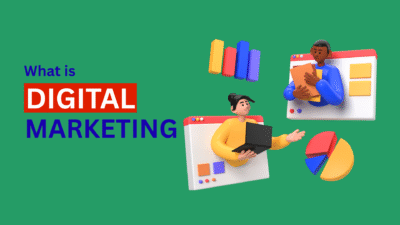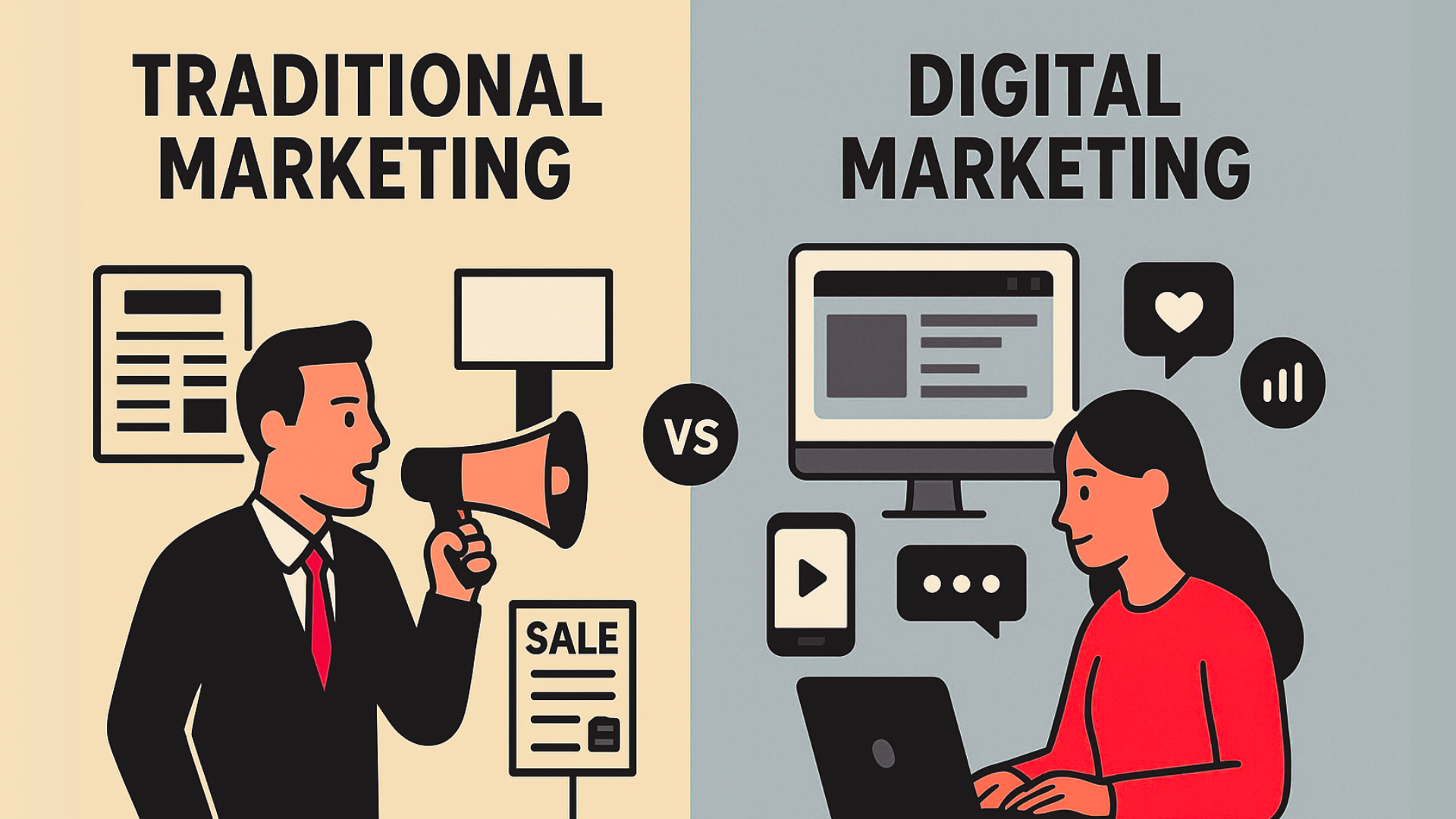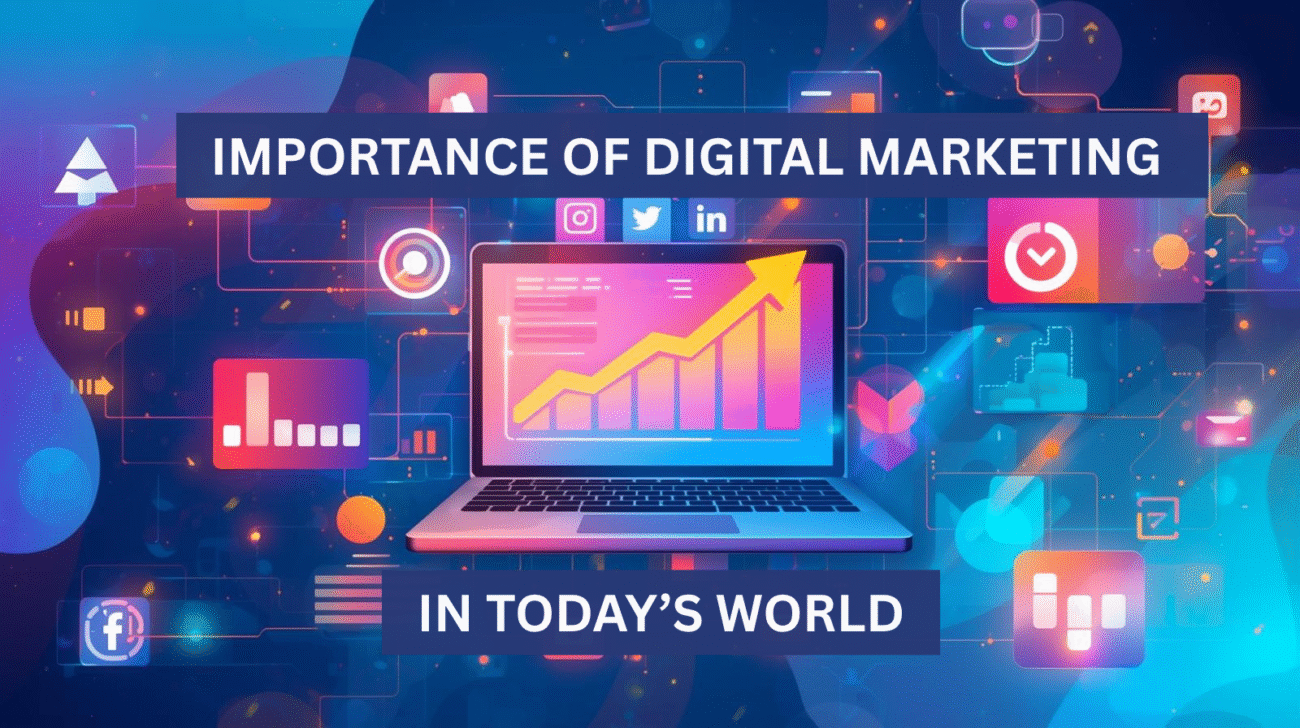The debate between Traditional vs Digital Marketing is not just about mediums — it’s about mindset, measurability, and modern customer behavior.
Marketing has always been the bridge between businesses and customers — but the way this bridge is built has changed dramatically over time.
In this 2025 guide, you’ll learn the clear differences, advantages, disadvantages, and use-cases for both types — so you can decide which approach suits your brand best.
What Is Traditional Marketing?
Traditional Marketing refers to any form of marketing that uses offline channels to promote products or services. It includes:
-
Print Media: Newspapers, magazines, flyers, brochures
-
Broadcast Media: Television and radio advertising
-
Outdoor Advertising: Billboards, posters, transit ads
-
Direct Mail: Catalogs, letters, postcards
-
Events & Exhibitions: Trade shows, roadshows, sponsorships
-
Telemarketing: Promotional calls and SMS campaigns
Traditional marketing is often one-way communication — a brand speaks to the audience, but rarely gets immediate feedback. It relies on broad reach and mass appeal rather than precision targeting.
Key Features:
-
High setup and distribution cost
-
Local or regional reach
-
Difficult to measure results
-
Long production cycles
-
Builds brand recall and trust
What Is Digital Marketing?

What Is Digital Marketing
Digital Marketing is the process of promoting products or services using online platforms and digital technologies. It connects brands with audiences where they spend most of their time — on the internet.
Major channels include:
-
Search Engine Optimization (SEO)
-
Search Engine Marketing (SEM / Google Ads)
-
Social Media Marketing (Facebook, Instagram, LinkedIn, TikTok, X)
-
Content Marketing (Blogs, Videos, Podcasts, Infographics)
-
Email Marketing
-
Affiliate and Influencer Marketing
-
Analytics and Automation Tools
Key Features:
-
Two-way communication (real engagement)
-
Precise audience targeting
-
Quick campaign launch and real-time optimization
-
Low entry cost and scalable budget
-
Measurable and data-driven performance
Traditional vs Digital Marketing: A Detailed Comparison
| Aspect | Traditional Marketing | Digital Marketing |
|---|---|---|
| Medium | Print, TV, Radio, Outdoor | Websites, Search, Social Media, Email |
| Reach | Local / Regional | Global, borderless reach |
| Audience Targeting | Broad demographics, location-based | Highly specific (interests, behavior, device, location) |
| Cost | Expensive production & ad space | Flexible, budget-friendly, pay-as-you-go |
| Speed | Slow to produce & distribute | Quick launch, instant editing |
| Engagement | One-way communication | Two-way, interactive (likes, shares, comments) |
| Measurement | Difficult; approximate metrics | Easy with analytics tools (Google Analytics, Meta Insights) |
| Personalization | Generic messaging | Personalized content for each user |
| ROI Tracking | Hard to measure | Measurable in real-time |
| Best For | Brand awareness, local visibility | Lead generation, online sales, global exposure |
Cost Comparison
| Expense Type | Traditional Marketing | Digital Marketing |
|---|---|---|
| Initial Setup | High (print, design, TV slot) | Low (setup campaigns online) |
| Maintenance | Costly & time-consuming | Minimal; automated tools available |
| Budget Control | Fixed costs | Fully adjustable — daily or monthly limits |
| ROI Measurement | Difficult | Transparent and trackable |
Example:
A 30-second TV ad can cost $2,000–$10,000+ per broadcast slot, while a digital campaign can start with $10–$50/day and reach thousands of targeted users online.
Audience & Targeting Difference
Traditional marketing targets audiences based on location, gender, or age through broad surveys.
Digital marketing allows precise micro-targeting using data like:
-
Search intent (keywords)
-
Interests & hobbies
-
Online behavior
-
Device usage
-
Purchase history
Example:
A local gym can show ads only to people aged 20–35 within 3 km of its location who’ve shown interest in “fitness” or “weight loss.”
That level of accuracy is impossible with traditional media.
Measurability & Analytics
Traditional Marketing:
-
Results are estimated — e.g., how many people might have seen a billboard.
-
Surveys and manual feedback methods used.
-
ROI is often unclear.
Digital Marketing:
-
Every impression, click, and conversion is recorded.
-
Tools like Google Analytics, Meta Business Suite, SEMrush show detailed insights.
-
Campaigns can be improved instantly based on data.
This is one of the biggest advantages of digital marketing — nothing is left to guesswork.
Engagement & Interaction
Traditional marketing is largely passive — audiences only receive the message.
Digital marketing is interactive — users can like, share, comment, DM, or click to buy instantly.
This interactivity builds trust, engagement, and loyalty — crucial in 2025 when customer relationships drive conversions more than ads alone.
Time & Flexibility
Traditional campaigns take weeks or months to plan and execute — print design, approvals, shoots, distribution, etc.
Digital marketing can launch within hours and adapt instantly.
Example:
If an ad isn’t performing well, you can pause it, tweak the visuals or headline, and relaunch in minutes — something impossible in traditional campaigns.
Lifespan of Campaigns
-
Traditional ads have limited exposure — once printed or aired, they fade.
-
Digital content can last indefinitely — blogs, YouTube videos, or evergreen posts keep driving traffic for years.
That’s why digital is called “always-on marketing.”
Credibility & Trust
While digital marketing dominates numbers, traditional marketing still builds emotional credibility.
A newspaper ad or TV spot can make a brand look established and trustworthy, especially for older audiences or premium products.
Best approach? Use both together for maximum impact — digital for performance, traditional for perception.
When to Use Each Type
| Scenario | Use Traditional Marketing | Use Digital Marketing |
|---|---|---|
| Local reach | Flyers, radio, local newspaper | Google My Business, local SEO, Facebook Ads |
| Brand credibility | TV or magazine features | PR articles, LinkedIn branding |
| Limited budget | Harder to manage | Easier; flexible daily budget |
| Need quick results | Slow to roll out | Instant reach, measurable ROI |
| Awareness campaign | Mass advertising | Viral content, influencer campaigns |
Pros and Cons
Advantages of Traditional Marketing
-
Builds trust and emotional connection
-
Tangible and memorable
-
Great for local communities
-
Effective for older demographics
Disadvantages
-
Expensive
-
Hard to measure ROI
-
Limited audience targeting
-
Slow to adapt or update
Advantages of Digital Marketing
-
Highly measurable and data-driven
-
Global reach with local precision
-
Cost-effective for all business sizes
-
Interactive and engaging
-
Real-time feedback and optimization
Disadvantages
-
High competition online
-
Algorithm and privacy policy changes
-
Ad fatigue and banner blindness
-
Requires continuous learning and updates
Hybrid Approach: The Best of Both Worlds
Most successful brands in 2025 use a hybrid marketing model, combining both approaches.
Examples:
-
Add QR codes on print ads linking to landing pages.
-
Use TV or radio to drive traffic to your website or social handles.
-
Promote offline events with social media campaigns.
This builds offline trust while leveraging online performance — a perfect blend for modern businesses.
Case Study Example
Brand: Local café in Mumbai
Traditional Marketing Used: Flyers, posters near colleges, local magazine ads.
Digital Marketing Used: Instagram Reels, Google Maps ads, WhatsApp broadcast offers.
Result:
Digital marketing increased orders by 50% within 3 months, while traditional marketing helped improve local brand recognition.
👉 The takeaway: Both can complement each other beautifully.
Future of Marketing in 2025 and Beyond
The marketing landscape is evolving rapidly. Here are trends shaping the future:
-
AI & Automation: Personalized campaigns powered by predictive analytics.
-
Voice Search Optimization: Adapting SEO for voice assistants (Alexa, Siri).
-
AR/VR Marketing: Immersive brand experiences.
-
Sustainability Marketing: Eco-conscious branding wins trust.
-
First-party Data: With stricter privacy laws, brands will rely on their own data.
Digital-first will dominate, but traditional touchpoints will remain valuable for brand authenticity.
Conclusion
The debate of Traditional vs Digital Marketing isn’t about which one is better — it’s about which one works best for your goals.
Traditional marketing builds credibility and awareness, while digital marketing offers precision, analytics, and scalability.
In 2025 and beyond, the key is integration — a balanced strategy that leverages the reach of traditional media and the power of digital engagement.
Remember:
-
Go digital or go invisible.
-
Measure everything.
-
Keep testing and evolving.
-
Build relationships, not just ads.
FAQs: Difference Between Traditional and Digital Marketing
Q1. Which is better — traditional or digital marketing?
It depends on your business goals and audience. Digital marketing is ideal for measurable, scalable campaigns, while traditional marketing builds offline brand authority.
Q2. Is digital marketing cheaper than traditional marketing?
Yes. You can start with a small budget online, test campaigns, and scale based on results — something traditional marketing doesn’t allow.
Q3. Can small businesses use both types together?
Absolutely. Combining local print or radio ads with digital channels like Google or social media can amplify results.
Q4. What is the biggest advantage of digital marketing?
Measurability and targeting. You can track every impression, click, and conversion in real time.
Q5. Will Traditional vs Digital Marketing disappear in the future?
No. It will evolve. While digital will dominate, traditional mediums will still play a key role








Wow nice blog